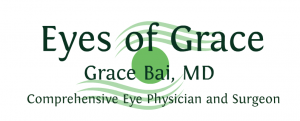As with all medicine, early diagnosis and treatment can help with your overall health. Just as with a physical, it makes sense to visit an eye MD for a comprehensive eye exam.
During a routine eye exam, your eye MD will begin by asking a series of questions about your medical and eye health history, including any noticeable eye problems. It is then followed by series of tests, which may include: Visual acuity, Refraction, Color Blindness, Glaucoma, Pupil dilation, Slit-lamp examination
Visual acuity is evaluated by determining the smallest letters you can read on a standardized eye chart from 14 to 20 feet away. Your eye MD will also test for refractive errors. There are 4 types of refractive error:
Myopia (nearsightedness) – Close objects will look clearer, but distant objects will appear blurred.
Hyperopia (farsightedness) – Distant objects will look clearer, but close objects will appear blurred.
Astigmatism – Both the distance and close vision may appear blurry.
Presbyopia – The eyes gradually lose the ability to see things up close, making reading difficult, especially in dim light.
Many people will have one or more of these errors. To correct a refractive errors, an eye MD may recommend glasses, contacts, or refractive surgery. The following lists some additional tests an eye MD may examine:
Eyelid health and function
Coordination of eye muscles
Pupil response to light
Side or peripheral vision
Intraocular pressure (the pressure inside the eye)
Anterior segment of the eye, including the cornea and the iris
Interior and back of the eye, including the retina.
After the examination, your eye MD will discuss the results with you. If there is any eye disease, treatments with medication, including eye drops may be recommended. In some cases, certain eye diseases require laser surgery or other surgical procedures. Some of the treatments are taken care of by your eye MD, or you may be referred to a sub-specialist such as a retina specialist.
Even if there are no particular problems, there are recommended intervals for eye examinations. The American Academy of Ophthalmology recommends the following schedule:
Infants
An initial eye exam within the first 3 months from birth
Follow up exam between ages 6 months and one year
Then again between age 3 to 3.5 years
Note: For children, eye exams can be given by your eye MD, pediatrician, family physicians, nurse practitioners, or physician assistants.
Adults
At least one eye exam between the ages of 20 and 29
At least two eye exams between the ages of 30 and 39
Eye exam every 2 to 4 years between the ages of 40 and 64
Eye exam every 1 to 2 years for those that are 65 and older
For those age 20 to 29 with risk factors for glaucoma, which includes people of African descent, or those who have family history of glaucoma, an eye exam is recommended every 3 to 5 years. And for those 30 to 39 at risk for glaucoma, an eye exam is recommended every 2 to 4 years.
Regular visits to an eye MD are good preventative medicine, and will help preserve and maximize vision throughout lifetime.
